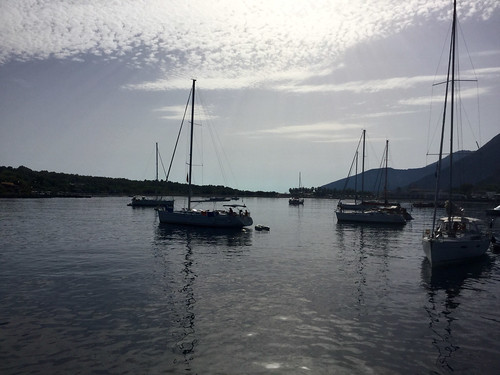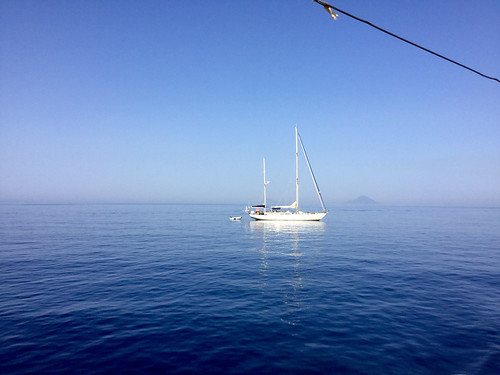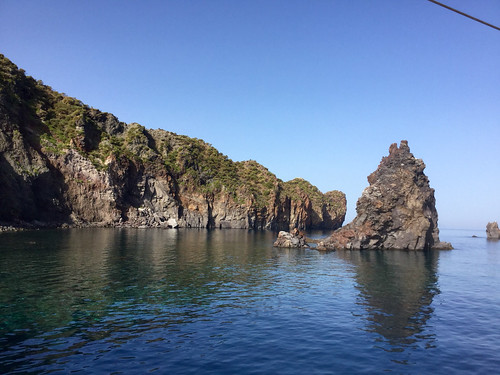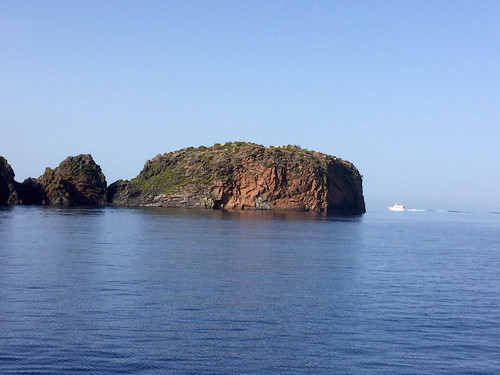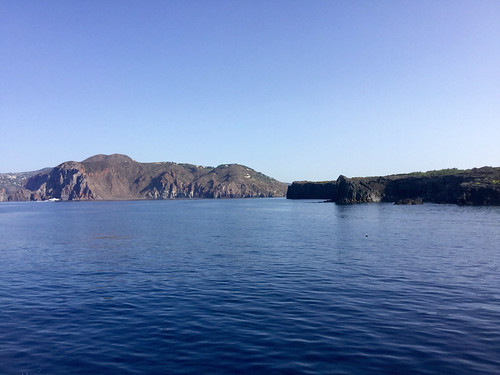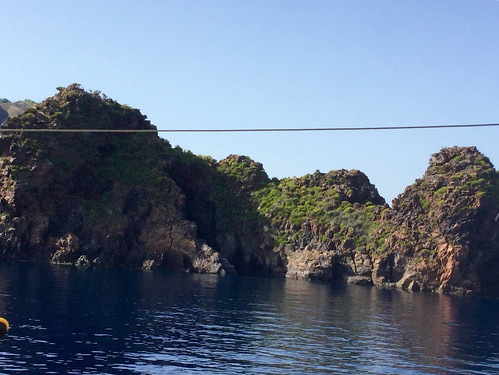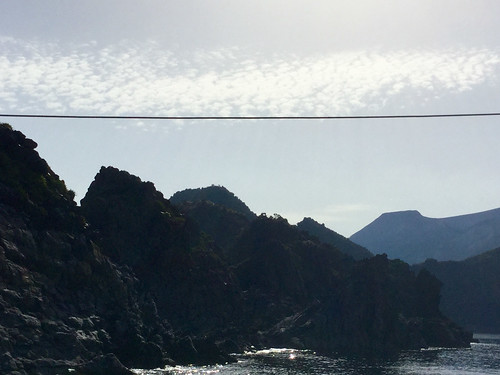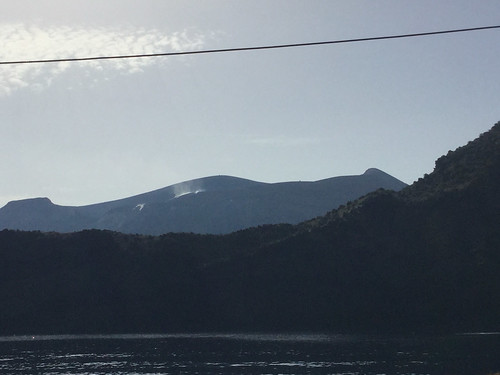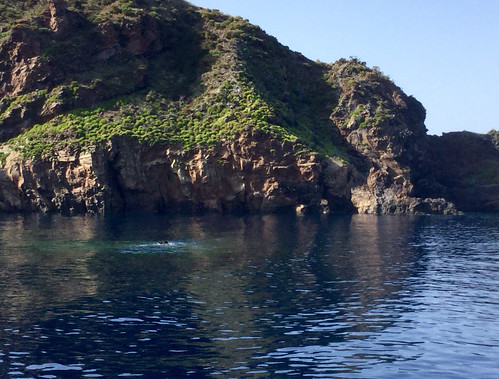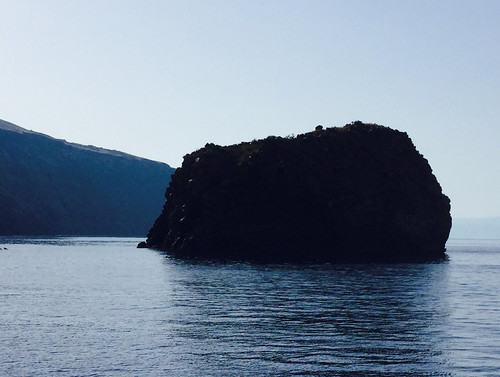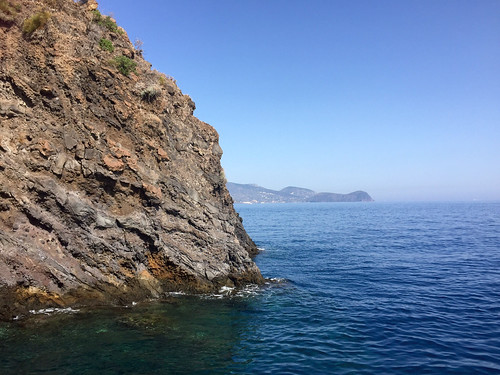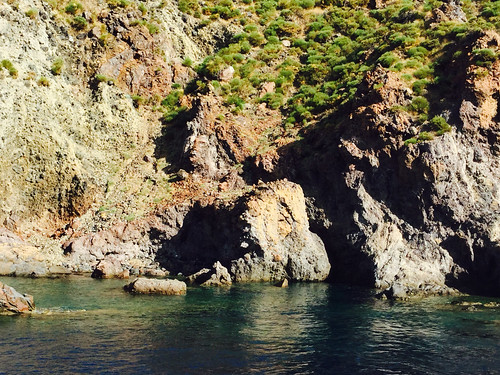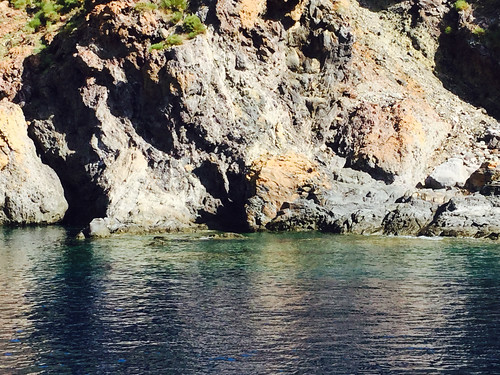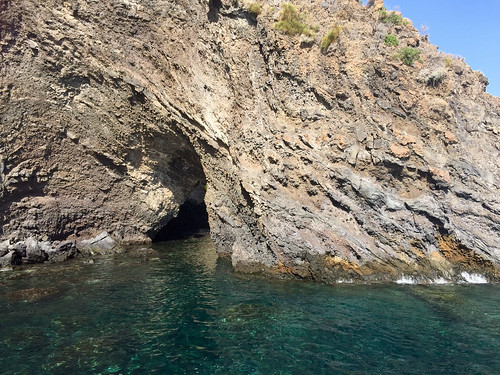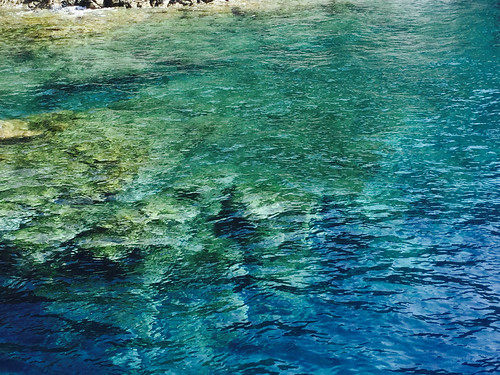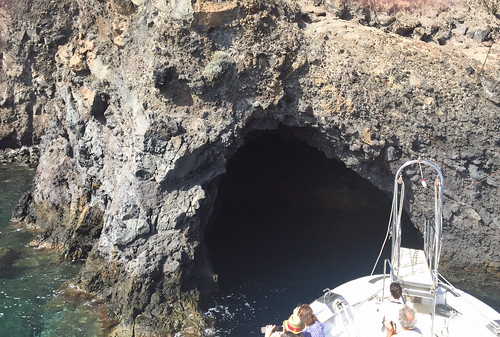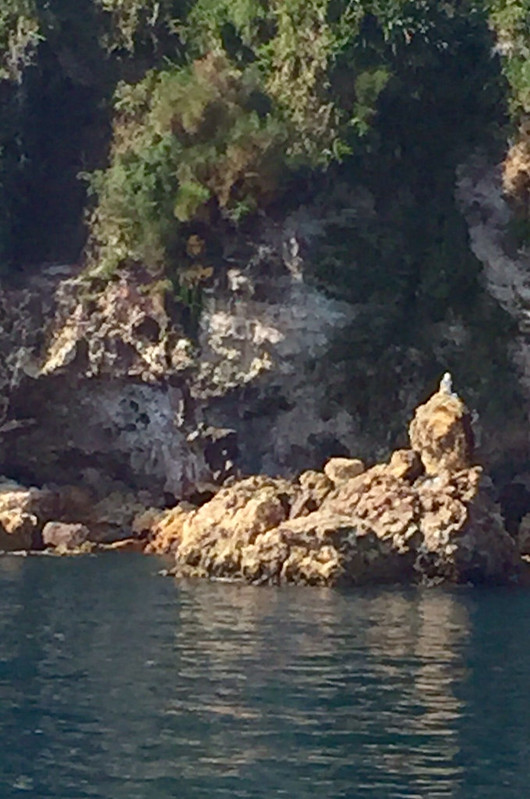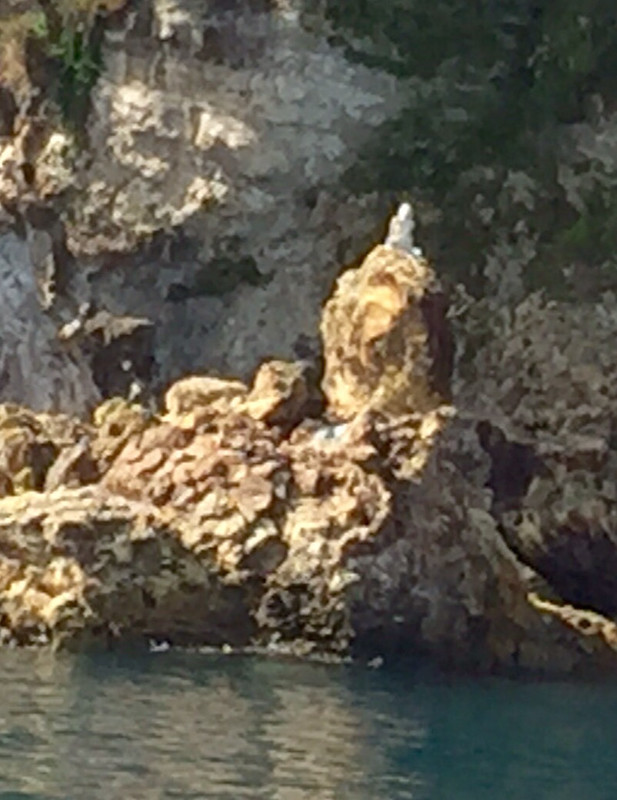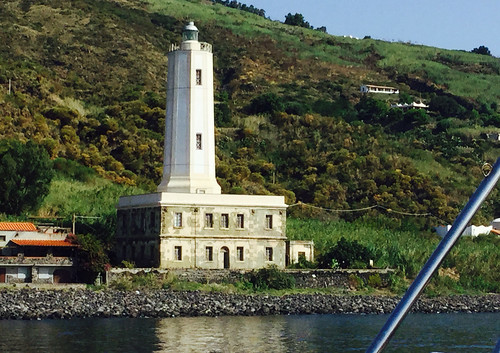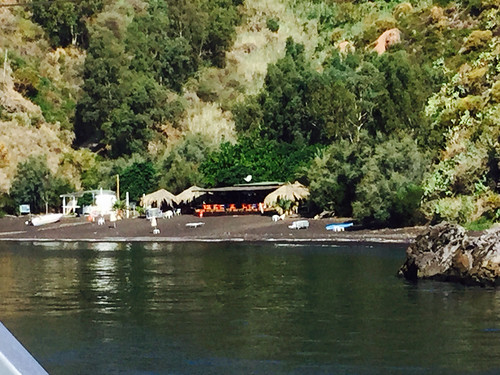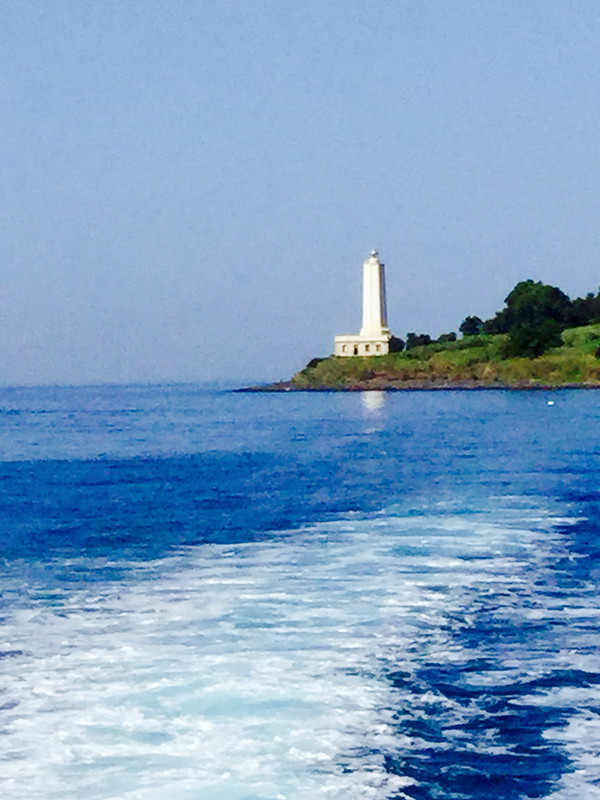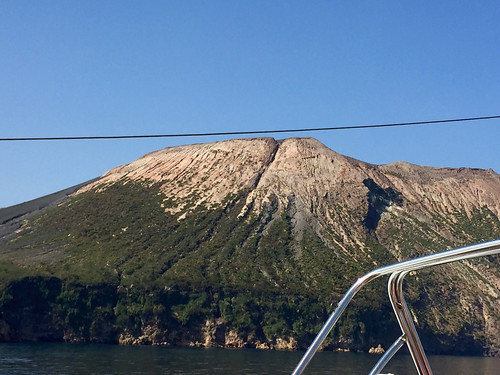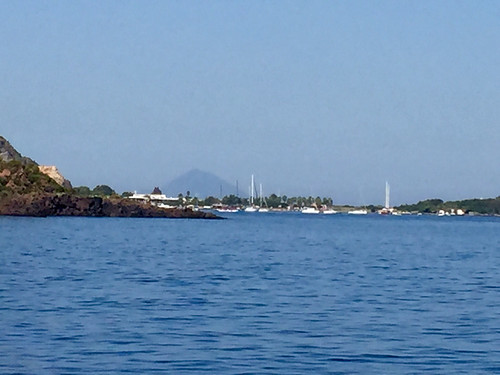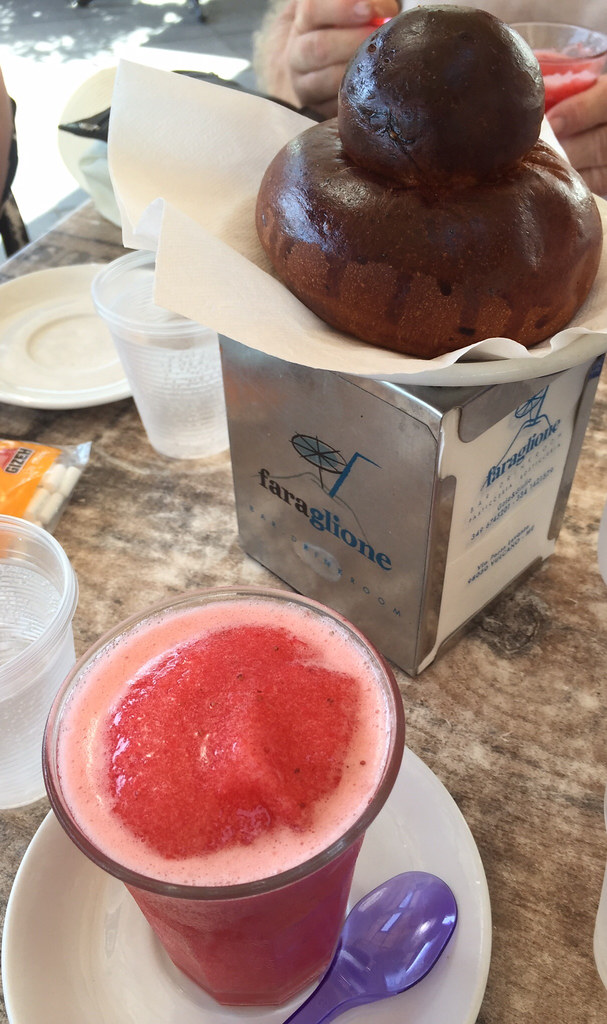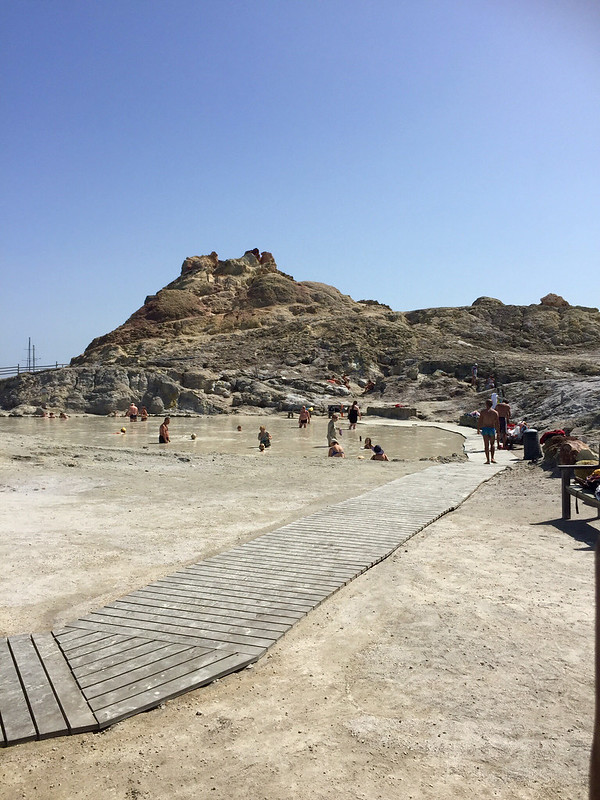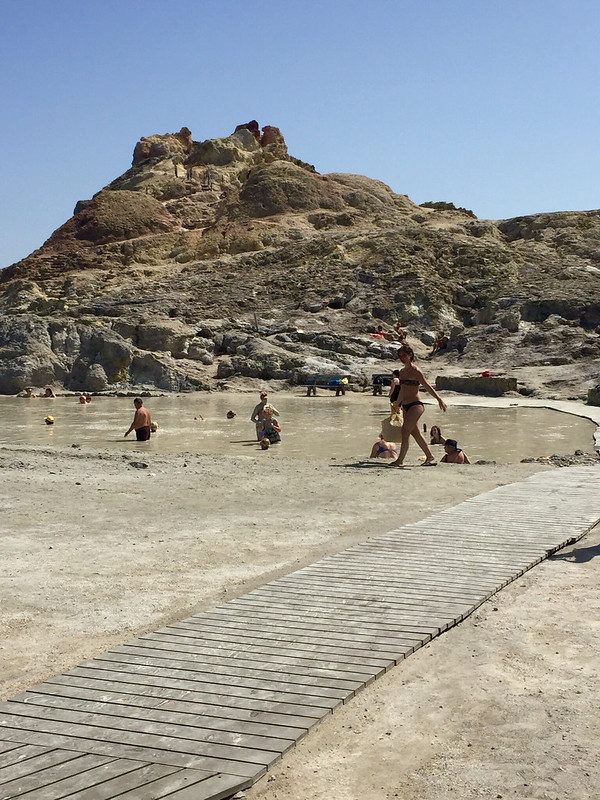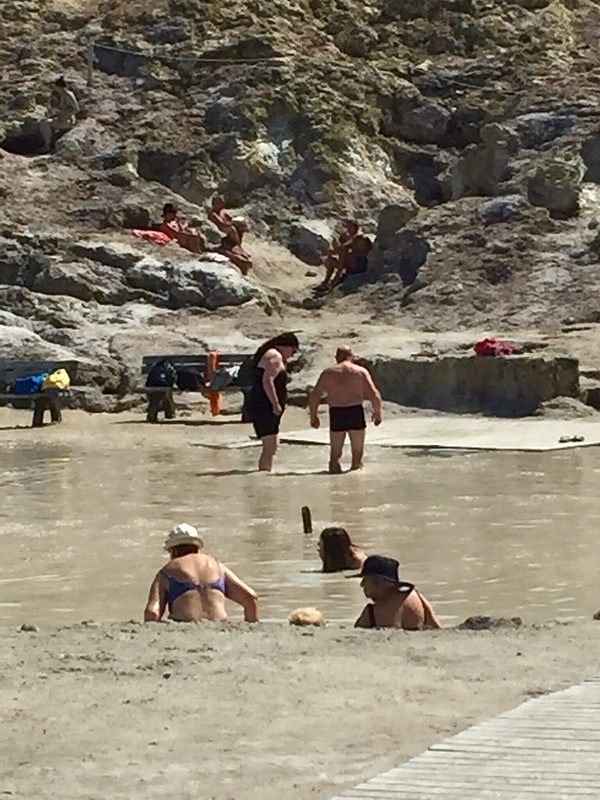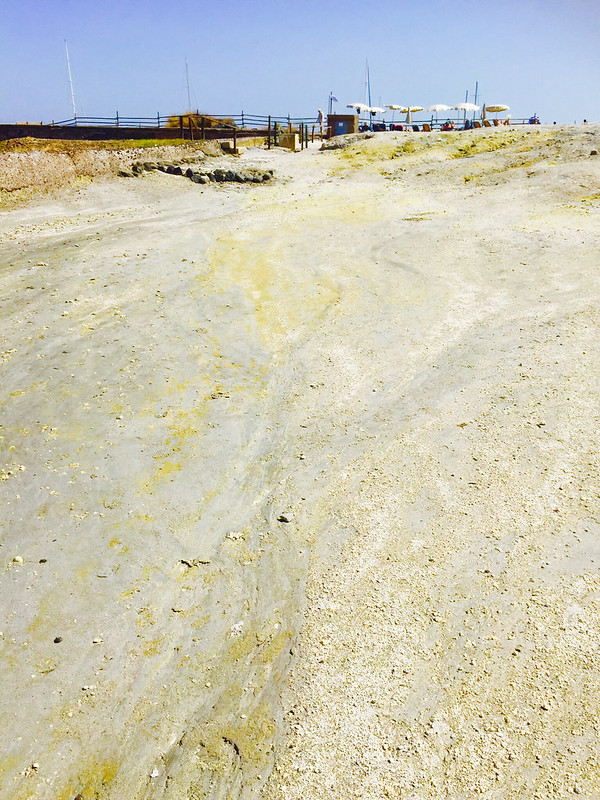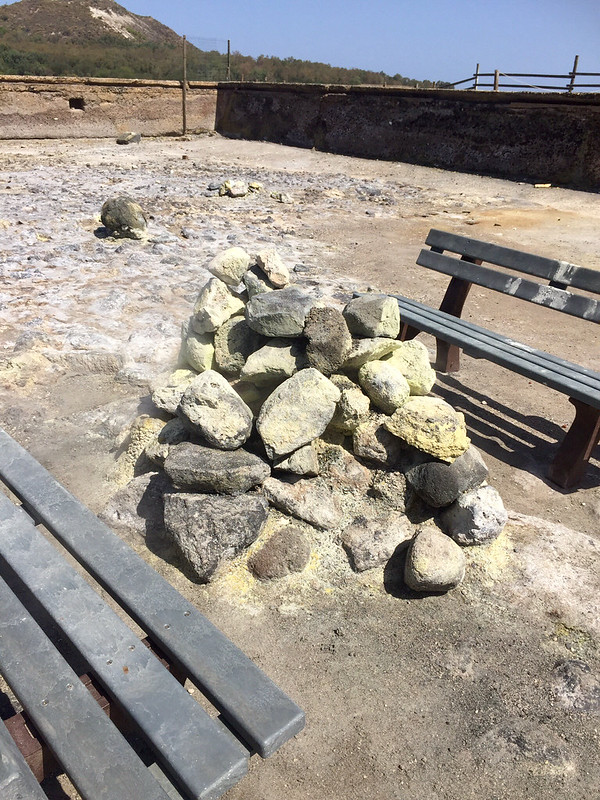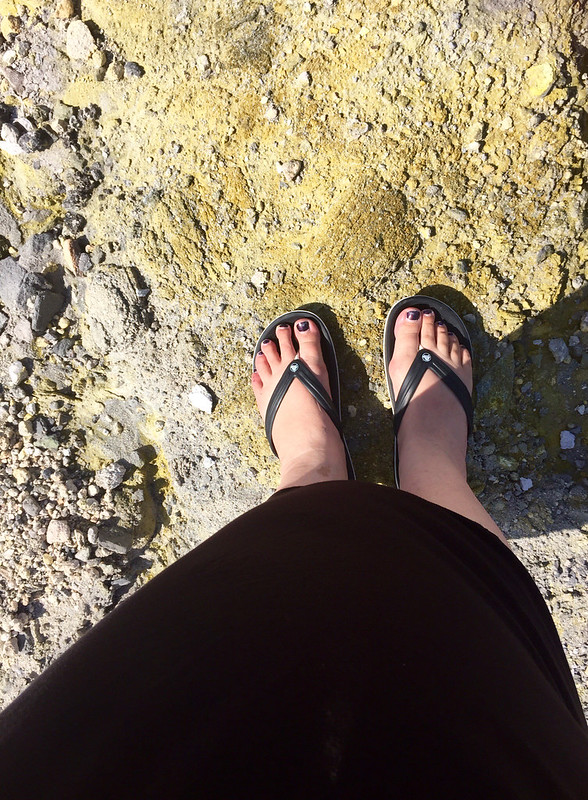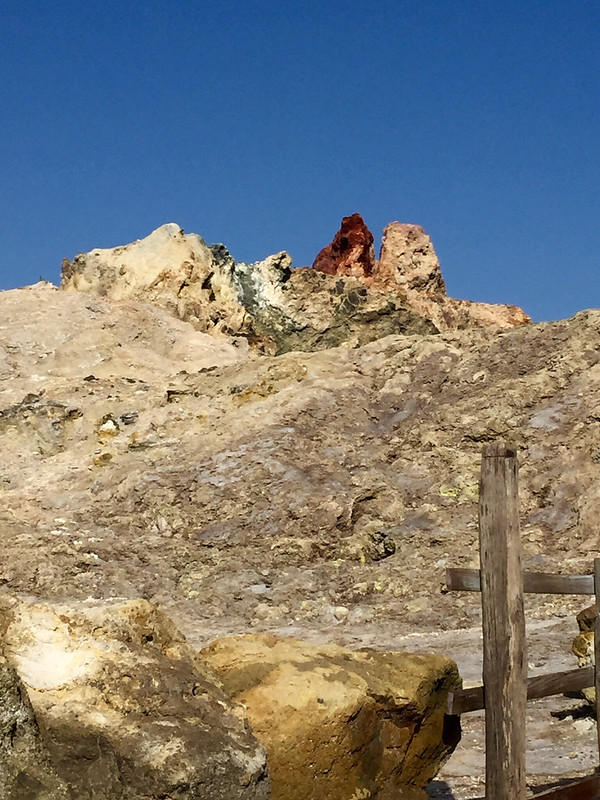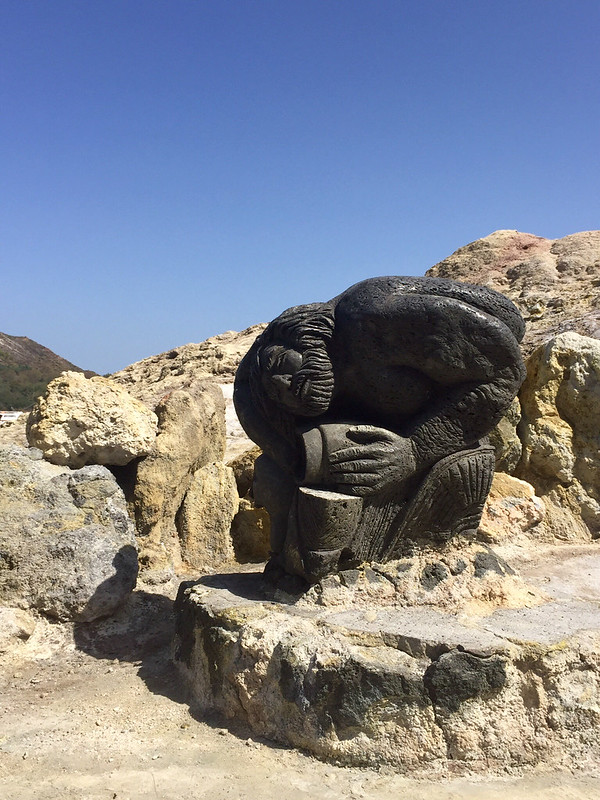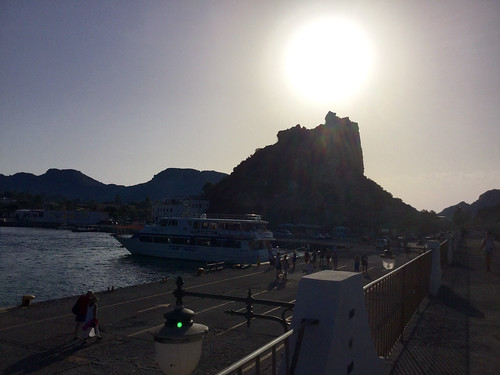Morgäääääähn. Es ist Montag, Wochenende ist durch, also früh aufstehen. Es geht zurück aufs Boot und auf die Nachbarinsel, nach Vulcano. Die Römer wussten, das hier Vulcanus, der Gott des Feuers seine Schmiede hat. Er gab der Insel den Namen, die Inseln gab allen Feuer, Lava und Asche speienden Bergen ihren Namen - Vulkan. Die Einwohner sind die Vucanier, nein die Vulcanari.
Wir umrunden die Insel und sehen etliche Grotten und Felsformationen, die Tiere oder Gesichter formen. Die bekannteste ist die Pferdegrotte (Grotta del Cavallo). Die Reiseleiterin hat mehrfach darauf hingewiesen, dass man mit sehr, sehr viel Fantasie den Kopf eines Pferdes erblicken kann. Na ja, vielleicht hat sie zuwenig Vorstellungskraft, aber ich habe zwei Pferdeköpfe gesehen, ohne viel Fantasie. Aber egal, ab ins Wasser. Es gibt noch die Johannes II.- Grotte, als wir hier halten, ertönt leises Kirchengeläut (vom Band). Hatte ich schon erwähnt, dass unser Kapitän einen guten Sinn für Inszenierung und perfekte Fotomotive besitzt? Es gibt auch noch das Becken der Venus (Piscina de Venere), ein natürliches Schwimmbecken. An einer anderen Stelle, ragt ein einzelner Fels aus dem Meer, auf dessen Seite man ein Gesicht ausmachen kann. Mit viel, viel Fantasie, wie unsere Reiseleitung nicht müde wurde, zu betonen. Gaaanz viel Fantasie, und überhaupt wären das alles nur Mythen der Einwohner. Und überhaupt schien ihr das alles etwas lächerlich. Allerdings gab es die Erklärung nur auf Italienisch und auf Französisch, also hab ich sie vielleicht nicht richtig verstanden. Aber nur vielleicht. Auf dem Felsen mit dem Gesicht saß eine weiße Marmorstatue in Gestalt einer jungen Frau. Diese war nicht von Wind, Wetter und Vulkan geschaffen, sondern von einem Künstler. Und hatte ein lebendes Vorbild, eine junge Frau von der Insel. Die Geschichte dahinter habe ich leider nicht verstanden.
Wir umrunden den Süden der Insel und kommen am Leuchtturm und dem kleinen Fischerdorf Gelso mit Strand und Trattoria. Laut Reiseführer ist der Leuchtturm extrem renovierungsbedürftig, aber dieser stammt von 2013. Vielleicht wurde inzwischen etwas getan, den Vulcano lebt ausschließlich vom Tourismus und von ganz wenig Landwirtschaft und Fischfang. Der Leuchturm sah jedenfalls ganz chic aus und leuchtete in weiß.
Bald gelangen wir wieder an den Hafen, also an das Häfchen und nun werden wir in die Freiheit entlassen und können tun und lassen was wir mögen. Wir mögen Kaffee und Granita. Auf der Insel kann man den Krater besteigen und in den Abgrund schauen bis er zurück starrt, aber nicht, wenn man Flipflops trägt, außerdem ist es auch so heiß genug. Und man kann im Modder spielen. Und am schwarzen Strand baden gehen. Und man hat den ganzen Tag Schwefeldunst in der Nase.
In der Nähe des Hafens gibt es ein natürliches Becken gefüllt mit warmem Wasser, Schlamm und vielen Dingen, die ein gut sortierter Chemiebaukasten so hergibt. Fango für alle, also für alle, die 2€ Eintritt und 1€ für die Dusche bezahlen wollen. Dann sucht man sich ein gemütliches Plätzchen, Vorsicht! nicht auf eine heiße Erdspalte setzen, sonst qualmt das Badekleid und seift sich gründlich mit Schlamm ein, lässt den in der Sonne trocknen und spült ihn im Tümpel wieder ab. Das hat durchaus einen gewissen Unterhaltungswert, die Leute sehen einfach komisch aus, und wenn man fertig mit der Prozedur ist, hat man im Bus einen Sitzplatz und keinen Sitznachbarn, denn man richt wie Plumpsklo am Bahnhof, seit zehn Jahren nicht saubergemacht. Ach so, und gesund ist es natürlich auch, für die Haut, und die Gelenke und so. Tapfer wie ich bin, hab ich meine Füße rein getaucht und hinterher abgeduscht, an den heißen Steinen noch eine Nase Schwefeldunst genommen, um die Nebenhöhlen frei zu kriegen, bin nun ganz gesund und kann weiter Ferien machen.
Vorbei an der Statue, die die Öffnung der Büchse der Pandora darstellt, gelangen wir auf die Halbinsel Vulcanello. Einst war das die achte Insel des Archipels, aber irgendwann entstand eine Landbrücke zwischen der großen und der kleinen Schmiede des Vulcanus und heute sind sie ein Großbetrieb. Allerdings gerade auf Null-Stunden-Kurzarbeit. Der Vulkan ruht, seit 1890. Seit der Römerzeit wurde hier Schwefel und Alaun abgebaut, aber die letzte große Eruption, die fast zwei Jahre dauerte, hat alle Förderanlagen zerstört. Die Büchse der Pandora ist geschlossen. Die Geologen allerdings erwarten zeitnah einen neuen Ausbruch. Darum ist die Insel überzogen mit einen dichten Netz aus Meßgeräten, um sofort warmen zu können, wenn die Büchse wieder geöffnet wird. Allerdings ist der Deckel nicht dicht, und es entweichen giftige Gase und Schwefeldämpfe. Darauf wird auch am Badestrand hingewiesen. Überall gibt es Schilder, die erklären, dass die Ausdünstungen des Vulakans zur Ohnmacht führen können. Und es gibt eine Strandwache. Mehrheitlich vermietet der junge Mann Strandliegen, aber er fischt auch Abfall aus dem Meer und wäre zur Stelle, wenn ein Schwimmer in Seenot geräte. Der Strand ist schwarz vom Vulkansand, aber der Sand ist relativ fein, das Wasser flach und an vielen Stellen sieht man Gasblasen unter Wasser aufsteigen und in regelmäßigen Abständen wehen Schwefeldämpfe heran. Der Stand liegt über unterseeischen Fumarolen, das macht auch das Wasser recht warm, and manchen Stellen heiß. Vorsicht hier, sonst ist man gleich gar. Ansonsten ist es totes Land, Vegetation hält es hier nicht aus, sie läßt ausrichten, man könne sie auf Salina treffen.
Yaaaawn! Monday. Weekend is done. Time to get up and onboard again to see the next island. It's Vulcano. The Roman knows that Vulcanus, the God of fire got his forge here. He gave the island his name. The island gave its name to all the fire, lava and ash spitting mountains - vulcan. The inhabitants are the Vulcanians, no the Vulacanaris.
We are circling the island and see a lot of caves and rock formations, which looks like animals or faces. The most famous is the horse cave (Grotta del cavallo). The guide lady told us again and again with much phantasy you can see the head of a horse at the rock, much, much phantasy. Don't know if she suffers from a lack of imagination, but I saw two horses with no phantasy at all. But anyway, into the sea. There is also the cave of Pope John II. and as we reach it, the soft sound of church bells was to hear (from tape). Did I already mentioned, that our captain got a good sense for dramaturgy and the best points for taking pictures? There is also the pond of Venus (piscina de Venere), a natural pool to swim in. At another place a single rock peaks out of the water and one side got the shape of a face, but you can only see it with a lot of imagination, a very lot. Lots of lot. And of course it's only local mythology. It's seems to be very hilarious to our guide, but she only talks in Italian and French, so maybe I got it not right, but only maybe. On top of the rock with the face was a withe marble statue of woman, not done by wind, weather and vulcan, but by an artist. It was shaped after the face of a young woman from the island, but I didn't got the story behind it.
We turning around the south cape of the island and passing the light house and the small fishermen village Gelso with beach and trattoria. The guide book says, the light house is in need of urgent renovation, but it was written in 2013. Maybe it's done meanwhile, because Vulcano exists from tourism, and very less agriculture and fishing. The light house looked very shiny and chic.
Soon we reach the port again, or shall I say the mini-porty. We are released now and can do what we wanna do, and we want Caffè and Granita. On the island you can climb up the crater and look into the abyss until it looks back, but not if you wear flip flops. And it's hot enough anyway. But you can play in the mud and swim at the black beach. And you can smell sulphur the whole day.
Near the port is a natural pond filled with warm water, mud and a lot of things you normally find in a vey organised chemistry set. Fango for everyone, for everyone who is willing to pay 2€ for the entry and 1€ for the shower. Then you look for a cosy spot, careful! don't sit on a hot crevice, otherwise the swimsuit will smoke, cover yourself completely with mud, dry at the sun and wash it away in the pond. That got a quite good amusement value, because people do look very funny and it makes sure you will have a seat in the bus next time and no neighbour on your side, because you smell like a station privy not cleaned in twenty years. Oh, yes, of course it's healthy too, for the skin, for the joints and so on. I was very brave and dip my feet in and took a shower and even took some sulphuric air at hot stones to clean the sinuses. Now I'm totally healthy again and can continue with my holidays.
Passing a statue showing the opening of the box of Pandora we come to the peninsula of Vulcanello. Once it was the eighth island of the archipelago, but then a land bridge arose and connected both islands. Today they are a big company, but at the moment on short time-work, zero hours. The vulcan is silent, since 1890. Since the days of the Romans sulphur and alum was mined here. But the last eruption, which lasted at least nearly two years, destroyed all conveyor equipment. The box of pandora is closed. But geologists expect a new eruption anytime, so the island is covered with measure instruments to warn anyone when the box opens again. But the lid is not really closed, and poisonous gases and sulphur fumes are leaking. They warn about that at the beach. Everywhere are signs telling that those gases can cause fainting. And there is a bay watch. Most of the time the young man is busy renting sun chairs, but he also collects litter from the sea and if a swimmer would get in maritime distress, he would come to salvage. The beach is black of vulcan sand, but it's soft sand. The water is not deep and now and than you can see bubbles arose under the sea and from time to time the wind brings the smell of sulphur. There is an undersea fumarole under the beach and it also keeps the water warm, hot at some spots. Careful here, otherwise you get boiled. Beside that, it's a dead land, the vegetation is all gone and left messages, you can meet it on Salina.
